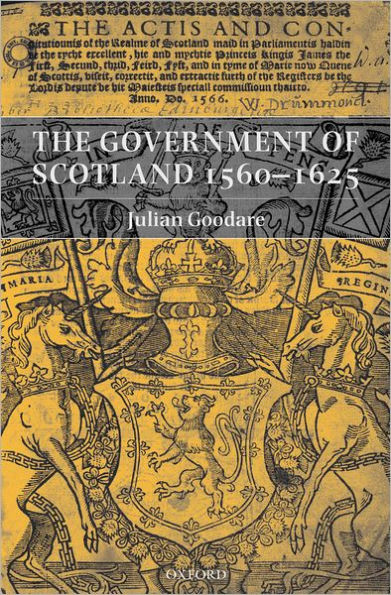The Government of Scotland 1560-1625
In The Government of Scotland 1560-1625 Goodare shows how Scotland was governed during the transition from Europe's decentralized medieval realms to modern sovereign states. The expanding institutions of government - crown, parliament, privy council, local courts - are detailed, but the book is structured around an analysis of governmental processes. A new framework is offered for understanding the concept of 'centre and localities': centralization happened in the localities.
Various interest groups participated in government and influenced its decisions. The nobility, in particular, exercised influence at every level. There was also English influence, both before and after the union of crowns in 1603. It is argued that the crown's continuing involvement after 1603 shows the common idea of 'absentee monarchy' to be misconceived. Goodare also pays particular attention to the harsh impact of government in the Highlands - where the chiefs were not full members of 'Scottish' political society - and on the common people - who were also excluded from normal political participation.
1100993314
Various interest groups participated in government and influenced its decisions. The nobility, in particular, exercised influence at every level. There was also English influence, both before and after the union of crowns in 1603. It is argued that the crown's continuing involvement after 1603 shows the common idea of 'absentee monarchy' to be misconceived. Goodare also pays particular attention to the harsh impact of government in the Highlands - where the chiefs were not full members of 'Scottish' political society - and on the common people - who were also excluded from normal political participation.
The Government of Scotland 1560-1625
In The Government of Scotland 1560-1625 Goodare shows how Scotland was governed during the transition from Europe's decentralized medieval realms to modern sovereign states. The expanding institutions of government - crown, parliament, privy council, local courts - are detailed, but the book is structured around an analysis of governmental processes. A new framework is offered for understanding the concept of 'centre and localities': centralization happened in the localities.
Various interest groups participated in government and influenced its decisions. The nobility, in particular, exercised influence at every level. There was also English influence, both before and after the union of crowns in 1603. It is argued that the crown's continuing involvement after 1603 shows the common idea of 'absentee monarchy' to be misconceived. Goodare also pays particular attention to the harsh impact of government in the Highlands - where the chiefs were not full members of 'Scottish' political society - and on the common people - who were also excluded from normal political participation.
Various interest groups participated in government and influenced its decisions. The nobility, in particular, exercised influence at every level. There was also English influence, both before and after the union of crowns in 1603. It is argued that the crown's continuing involvement after 1603 shows the common idea of 'absentee monarchy' to be misconceived. Goodare also pays particular attention to the harsh impact of government in the Highlands - where the chiefs were not full members of 'Scottish' political society - and on the common people - who were also excluded from normal political participation.
265.0
Out Of Stock
5
1

The Government of Scotland 1560-1625
360
The Government of Scotland 1560-1625
360
265.0
Out Of Stock

Product Details
| ISBN-13: | 9780199243549 |
|---|---|
| Publisher: | Oxford University Press |
| Publication date: | 12/16/2004 |
| Pages: | 360 |
| Product dimensions: | 6.00(w) x 9.30(h) x 1.10(d) |
About the Author
From the B&N Reads Blog
